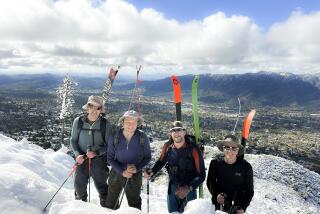Blade running
- Share via
THE skier lurches downhill, carving gracefully in parabolic swoops, taking care to avoid ... gophers and grass stains?
Welcome to the chlorophylled world of grass skiing, in which snowblowers make way for lawn mowers and the slalom courses come with hay fever.
A Euro invention that began as a way for avid skiers and their mountain-boarding counterparts to keep carving when the snows vanish, the sport has a world championship circuit and draws fans in Germany, Taiwan and Japan. Yet in the U.S., apart from golfers sliding on fairways, grass skiing is invisible outside of Bryce Resort, a ski spot in Virginia’s Shenandoah Mountains.
“Our hill is pretty much like a golf course,” says Ryan Locher, who at 26 is continuing the tradition his father, Horst, started in the late ‘60s, when he introduced the sport to Americans. “We mow everything and take out all the rocks.” Groundskeepers also remove stumps and replace topsoil to smooth the ride.
Locher’s location is conducive to the sport. Lower-elevation eastern resorts need grassy slopes to minimize snowmelt during the mild winters, but this would be impractical in many Western ski spots, where greater snowfall and rocky slopes aren’t grass-friendly. So you may want to hold off investing in grass skis, which require constant maintenance to keep them turf-free.
Lawn landings are considerably less forgiving than the white stuff. Even with plush fairways, Locher and his buddies don hockey pads and helmets for the trip down. Speeds can reach 45 mph, comparable to the real thing.
“It hurts a little more to fall,” he says. Knees don’t take a beating in grass skiing like they do from the chattering edges of regular skis, but falling can lead to giant shoulder plants. Locher broke his arm in just such a fashion.
“I’m from a ski racing background, and racers are pretty much the only people who do this,” he said. “I think it’s a blast.”
-- Emmett Berg
More to Read
Sign up for The Wild
We’ll help you find the best places to hike, bike and run, as well as the perfect silent spots for meditation and yoga.
You may occasionally receive promotional content from the Los Angeles Times.






